毕业论文英文参考文献与译文
本科毕业设计(论文)外文翻译基本规范
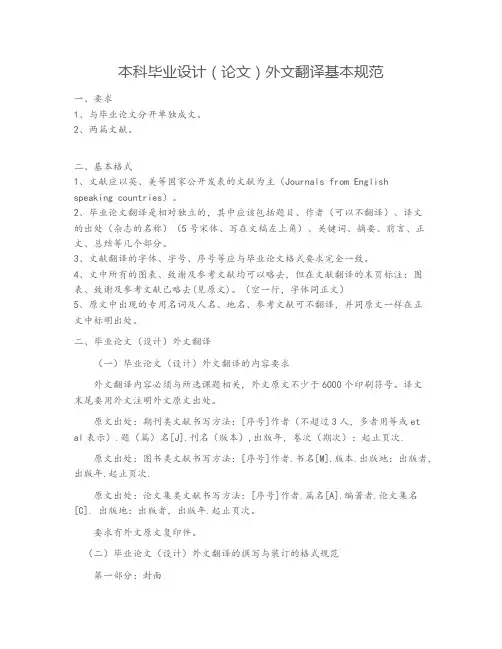
本科毕业设计(论文)外文翻译基本规范一、要求1、与毕业论文分开单独成文。
2、两篇文献。
二、基本格式1、文献应以英、美等国家公开发表的文献为主(Journals from English speaking countries)。
2、毕业论文翻译是相对独立的,其中应该包括题目、作者(可以不翻译)、译文的出处(杂志的名称)(5号宋体、写在文稿左上角)、关键词、摘要、前言、正文、总结等几个部分。
3、文献翻译的字体、字号、序号等应与毕业论文格式要求完全一致。
4、文中所有的图表、致谢及参考文献均可以略去,但在文献翻译的末页标注:图表、致谢及参考文献已略去(见原文)。
(空一行,字体同正文)5、原文中出现的专用名词及人名、地名、参考文献可不翻译,并同原文一样在正文中标明出处。
二、毕业论文(设计)外文翻译(一)毕业论文(设计)外文翻译的内容要求外文翻译内容必须与所选课题相关,外文原文不少于6000个印刷符号。
译文末尾要用外文注明外文原文出处。
原文出处:期刊类文献书写方法:[序号]作者(不超过3人,多者用等或et al表示).题(篇)名[J].刊名(版本),出版年,卷次(期次):起止页次.原文出处:图书类文献书写方法:[序号]作者.书名[M].版本.出版地:出版者,出版年.起止页次.原文出处:论文集类文献书写方法:[序号]作者.篇名[A].编著者.论文集名[C]. 出版地:出版者,出版年.起止页次。
要求有外文原文复印件。
(二)毕业论文(设计)外文翻译的撰写与装订的格式规范第一部分:封面1.封面格式:见“毕业论文(设计)外文翻译封面”。
普通A4纸打印即可。
第二部分:外文翻译主题1.标题一级标题,三号字,宋体,顶格,加粗二级标题,四号字,宋体,顶格,加粗三级标题,小四号字,宋体,顶格,加粗2.正文小四号字,宋体。
第三部分:版面要求论文开本大小:210mm×297mm(A4纸)版芯要求:左边距:25mm,右边距:25mm,上边距:30mm,下边距:25mm,页眉边距:23mm,页脚边距:18mm字符间距:标准行距:1.25倍页眉页角:页眉的奇数页书写—浙江师范大学学士学位论文外文翻译。
毕业论文英文参考文献与译文
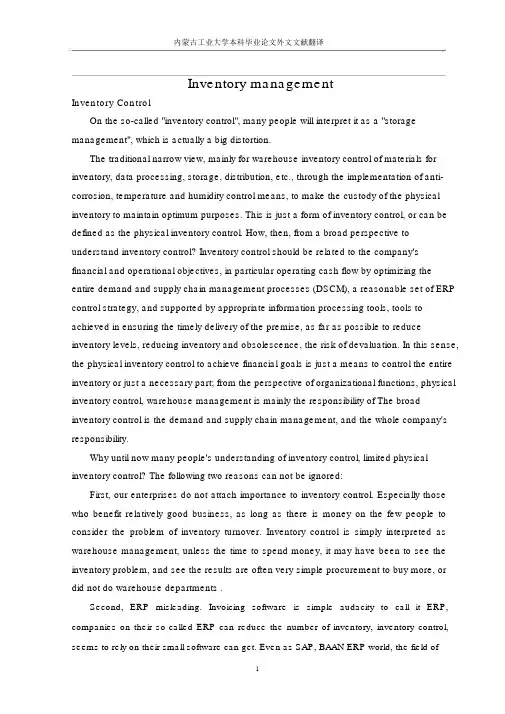
Inventory managementInventory ControlOn the so-called "inventory control", many people will interpret it as a "storage management", which is actually a big distortion.The traditional narrow view, mainly for warehouse inventory control of materials for inventory, data processing, storage, distribution, etc., through the implementation of anti-corrosion, temperature and humidity control means, to make the custody of the physical inventory to maintain optimum purposes. This is just a form of inventory control, or can be defined as the physical inventory control. How, then, from a broad perspective to understand inventory control? Inventory control should be related to the company's financial and operational objectives, in particular operating cash flow by optimizing the entire demand and supply chain management processes (DSCM), a reasonable set of ERP control strategy, and supported by appropriate information processing tools, tools to achieved in ensuring the timely delivery of the premise, as far as possible to reduce inventory levels, reducing inventory and obsolescence, the risk of devaluation. In this sense, the physical inventory control to achieve financial goals is just a means to control the entire inventory or just a necessary part; from the perspective of organizational functions, physical inventory control, warehouse management is mainly the responsibility of The broad inventory control is the demand and supply chain management, and the whole company's responsibility.Why until now many people's understanding of inventory control, limited physical inventory control? The following two reasons can not be ignored:First, our enterprises do not attach importance to inventory control. Especially those who benefit relatively good business, as long as there is money on the few people to consider the problem of inventory turnover. Inventory control is simply interpreted as warehouse management, unless the time to spend money, it may have been to see the inventory problem, and see the results are often very simple procurement to buy more, or did not do warehouse departments .Second, ERP misleading. Invoicing software is simple audacity to call it ERP, companies on their so-called ERP can reduce the number of inventory, inventory control, seems to rely on their small software can get. Even as SAP, BAAN ERP world, the field ofthese big boys, but also their simple modules inside the warehouse management functionality is defined as "inventory management" or "inventory control." This makes the already not quite understand what our inventory control, but not sure what is inventory control.In fact, from the perspective of broadly understood, inventory control, shouldinclude the following:First, the fundamental purpose of inventory control. We know that the so-called world-class manufacturing, two key assessment indicators (KPI) is, customer satisfaction and inventory turns, inventory turns and this is actually the fundamental objective of inventory control.Second, inventory control means. Increase inventory turns, relying solely on the so-called physical inventory control is not enough, it should be the demand and supply chain management process flow of this large output, and this big warehouse management processes in addition to including this link, the more important The section also includes: forecasting and order processing, production planning and control, materials planning and purchasing control, inventory planning and forecasting in itself, as well as finished products, raw materials, distribution and delivery of the strategy, and even customs management processes.And with the demand and supply chain management processes throughout the process, it is the information flow and capital flow management. In other words, inventory itself is across the entire demand and supply management processes in all aspects of inventory control in order to achieve the fundamental purpose, it must control all aspects of inventory, rather than just manage the physical inventory at hand.Third, inventory control, organizational structure and assessment.Since inventory control is the demand and supply chain management processes, output, inventory control to achieve the fundamental purpose of this process must be compatible with a rational organizational structure. Until now, we can see that many companies have only one purchasing department, purchasing department following pipe warehouse. This is far short of inventory control requirements. From the demand and supply chain management process analysis, we know that purchasing and warehouse management is the executive arm of the typical, and inventory control should focus on prevention, the executive branch is very difficult to "prevent inventory" for the simple reason that they assessment indicatorsin large part to ensure supply (production, customer). How the actual situation, a reasonable demand and supply chain management processes, and thus set the corresponding rational organizational structure and is a question many of our enterprisesto exploreThe role of inventory controlInventory management is an important part of business management. In the production and operation activities, inventory management must ensure that both the production plant for raw materials, spare parts demand, but also directly affect the purchasing, sales of share, sales activities. To make an inventory of corporate liquidity, accelerate cash flow, the security of supply under the premise of minimizing Yaku funds, directly affects the operational efficiency. Ensure the production and operation needs of the premise, so keep inventories at a reasonable level; dynamic inventory control, timely, appropriate proposed order to avoid over storage or out of stock; reduce inventory footprint, lower total cost of inventory; control stock funds used to accelerate cash flow.Problems arising from excessive inventory: increased warehouse space andinventory storage costs, thereby increasing product costs; take a lot of liquidity, resultingin sluggish capital, not only increased the burden of payment of interest, etc., would affect the time value of money and opportunity income; finished products and raw materials caused by physical loss and intangible losses; a large number of enterprise resource idle, affecting their rational allocation and optimization; cover the production, operation of the whole process of the various contradictions and problems, is not conducive to improve the management level.Inventory is too small the resulting problems: service levels caused a decline in the profit impact of marketing and corporate reputation; production system caused by inadequate supply of raw materials or other materials, affecting the normal production process; to shorten lead times, increase the number of orders, so order (production) costs; affect the balance of production and assembly of complete sets.NotesInventory management should particularly consider the following two questions:First, according to sales plans, according to the planned production of the goods circulated in the market, we should consider where, how much storage.Second, starting from the level of service and economic benefits to determine howto ensure inventories and supplementary questions.The two problems with the inventory in the logistics process functions.In general, the inventory function:(1)to prevent interrupted. Received orders to shorten the delivery of goods fromthe time in order to ensure quality service, at the same time to prevent out of stock.(2)to ensure proper inventory levels, saving inventory costs.(3)to reduce logistics costs. Supplement with the appropriate time interval compatible with the reasonable demand of the cargo in order to reduce logistics costs, eliminate or avoid sales fluctuations.(4)ensure the production planning, smooth to eliminate or avoid sales fluctuations.(5)display function.(6)reserve. Mass storage when the price falls, reduce losses, to respond to disasters and other contingencies.About the warehouse (inventory) on what the question, we must consider the number and location. If the distribution center, it should be possible according to customer needs, set at an appropriate place; if it is stored in central places to minimize the complementary principle to the distribution centers, there is no place certain requirements. When the stock base is established, will have to take into account are stored in various locations in what commodities.库存管理库存控制在谈到所谓“库存控制”的时候,很多人将其理解为“仓储管理”,这实际上是个很大的曲解。
毕业论文和外文翻译要求内容
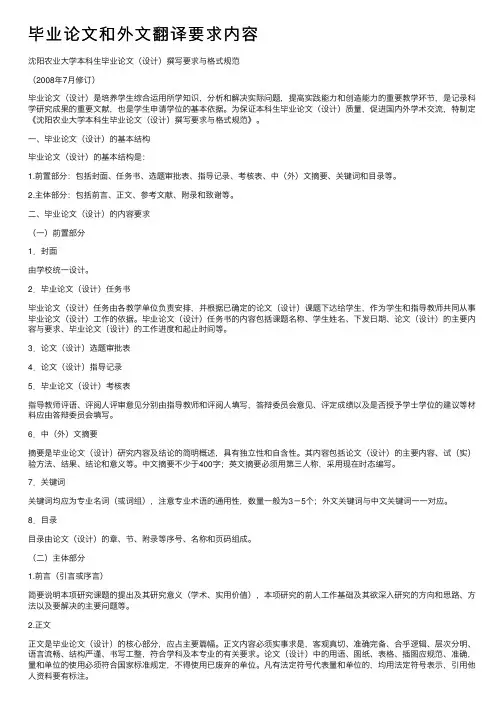
毕业论⽂和外⽂翻译要求内容沈阳农业⼤学本科⽣毕业论⽂(设计)撰写要求与格式规范(2008年7⽉修订)毕业论⽂(设计)是培养学⽣综合运⽤所学知识,分析和解决实际问题,提⾼实践能⼒和创造能⼒的重要教学环节,是记录科学研究成果的重要⽂献,也是学⽣申请学位的基本依据。
为保证本科⽣毕业论⽂(设计)质量,促进国内外学术交流,特制定《沈阳农业⼤学本科⽣毕业论⽂(设计)撰写要求与格式规范》。
⼀、毕业论⽂(设计)的基本结构毕业论⽂(设计)的基本结构是:1.前置部分:包括封⾯、任务书、选题审批表、指导记录、考核表、中(外)⽂摘要、关键词和⽬录等。
2.主体部分:包括前⾔、正⽂、参考⽂献、附录和致谢等。
⼆、毕业论⽂(设计)的内容要求(⼀)前置部分1.封⾯由学校统⼀设计。
2.毕业论⽂(设计)任务书毕业论⽂(设计)任务由各教学单位负责安排,并根据已确定的论⽂(设计)课题下达给学⽣,作为学⽣和指导教师共同从事毕业论⽂(设计)⼯作的依据。
毕业论⽂(设计)任务书的内容包括课题名称、学⽣姓名、下发⽇期、论⽂(设计)的主要内容与要求、毕业论⽂(设计)的⼯作进度和起⽌时间等。
3.论⽂(设计)选题审批表4.论⽂(设计)指导记录5.毕业论⽂(设计)考核表指导教师评语、评阅⼈评审意见分别由指导教师和评阅⼈填写,答辩委员会意见、评定成绩以及是否授予学⼠学位的建议等材料应由答辩委员会填写。
6.中(外)⽂摘要摘要是毕业论⽂(设计)研究内容及结论的简明概述,具有独⽴性和⾃含性。
其内容包括论⽂(设计)的主要内容、试(实)验⽅法、结果、结论和意义等。
中⽂摘要不少于400字;英⽂摘要必须⽤第三⼈称,采⽤现在时态编写。
7.关键词关键词均应为专业名词(或词组),注意专业术语的通⽤性,数量⼀般为3-5个;外⽂关键词与中⽂关键词⼀⼀对应。
8.⽬录⽬录由论⽂(设计)的章、节、附录等序号、名称和页码组成。
(⼆)主体部分1.前⾔(引⾔或序⾔)简要说明本项研究课题的提出及其研究意义(学术、实⽤价值),本项研究的前⼈⼯作基础及其欲深⼊研究的⽅向和思路、⽅法以及要解决的主要问题等。
毕业论文的参考文献的英文翻译与整理
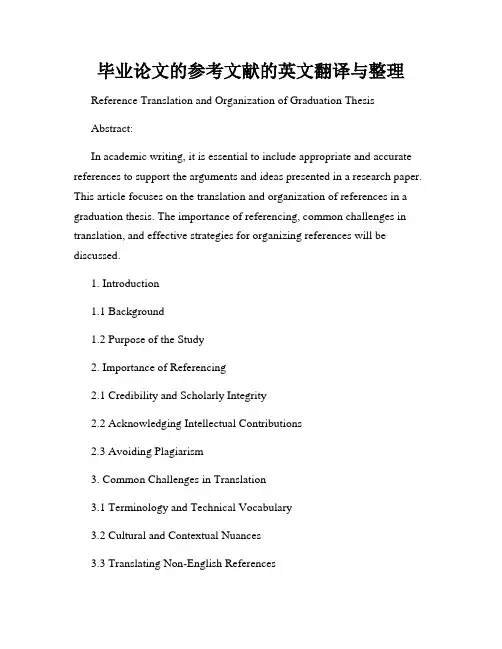
毕业论文的参考文献的英文翻译与整理Reference Translation and Organization of Graduation ThesisAbstract:In academic writing, it is essential to include appropriate and accurate references to support the arguments and ideas presented in a research paper. This article focuses on the translation and organization of references in a graduation thesis. The importance of referencing, common challenges in translation, and effective strategies for organizing references will be discussed.1. Introduction1.1 Background1.2 Purpose of the Study2. Importance of Referencing2.1 Credibility and Scholarly Integrity2.2 Acknowledging Intellectual Contributions2.3 Avoiding Plagiarism3. Common Challenges in Translation3.1 Terminology and Technical Vocabulary3.2 Cultural and Contextual Nuances3.3 Translating Non-English References4. Strategies for Translating References4.1 Literal Translation4.2 Paraphrasing4.3 Maintaining Consistency5. Organization of References5.1 Citation Styles5.2 Creating a Reference List5.3 Formatting Guidelines6. Tools and Resources for Reference Translation6.1 Online Translation Tools6.2 Electronic Databases and Libraries6.3 Style Guides and Manuals7. ConclusionReferences (References should be listed in alphabetical order according to the citation style used in the graduation thesis)Please note that the above format is a general example. Depending on the specific requirements of your graduation thesis, you may need to modify the structure and add additional sections.In conclusion, the translation and organization of references in a graduation thesis play a crucial role in maintaining the credibility andintegrity of the research. By accurately translating and properly organizing references, researchers can provide readers with easily accessible information and demonstrate their acknowledgment of the intellectual contributions of others. It is important to be meticulous and consistent in following the chosen citation style to ensure the professional presentation of the references.。
java英文参考文献(20210507015628)
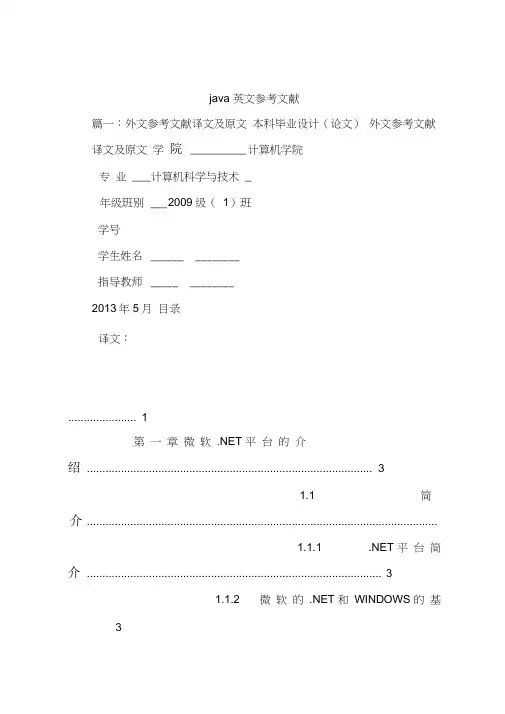
java 英文参考文献篇一:外文参考文献译文及原文本科毕业设计(论文)外文参考文献译文及原文学院_________ 计算机学院专业___计算机科学与技术_年级班别___ 2009级(1)班学号学生姓名______ ________指导教师_____ ________2013年5月目录译文: (1)第一章微软.NET 平台的介绍 (3)1.1 简介.................................................................................................................1.1.1 .NET 平台简介 (3)1.1.2 微软的.NET 和WINDOWS 的基3因 (4)1.1.3 微软.NET 体系结构 (4)1.1.4 .NET 平台的特点 (4)J \\\ ................................................................................................................................................................................................................................................................................................................................ ■1.1.5 多国语言的发展 (5)1.1.6 平台和处理器独立性 (6)1.1.7 自动内存管理 (7)1.1.8 支持的版本 (7)1.1.9 支持的开放标准 (8)1.1.10 配置简单 (8)1.1.11 分布式体系结构 (9)1.1.12 与非托管代码的互用 (9)原文:Foreword ..................................................................................................... .............................. 11 Chapter1 Introduction of the Microsoft .NET Platform 131.1 Introduction ................................................................................................. .. (13)1.1.1 Introduction of the .NET Platform (13)1.1.2 Microsoft .NET and WindowsDNA (15)1.1.3 Microsoft .NET Architecture Hierarchy ....................................151.1.4 Features of the .NET Platform (16)1.1.5 Multilanguage Development (17)1.1.6 Platform and Processor Independence (18)1.1.7 Automatic Memory Management (19)1.1.8 Versioning Support (20)1.1.9 Support for OpenStandards (21)1.1.10 Easy Deployment (22)1.1.11 Distributed Architecture (23)1.1.12 Interoperability with Unmanaged Code (23)译文:、尸■、亠前言在电脑软件的历史上,很少有一种技术能够得到开发者和业界如此强烈的正面响应。
商务英语毕业论文文献
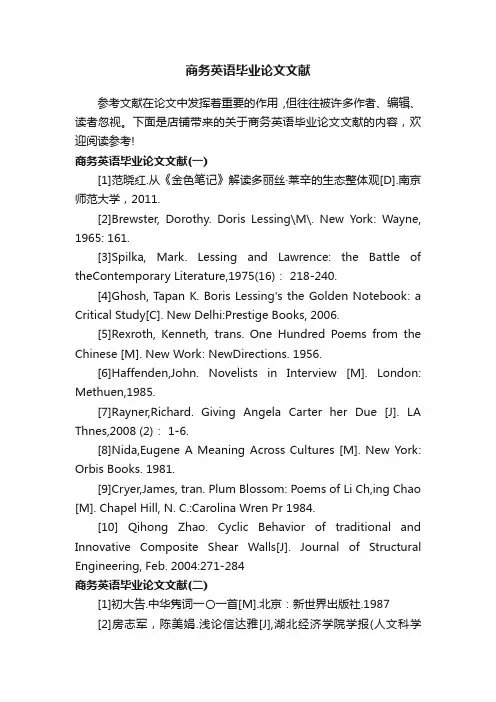
商务英语毕业论文文献参考文献在论文中发挥着重要的作用,但往往被许多作者、编辑、读者忽视。
下面是店铺带来的关于商务英语毕业论文文献的内容,欢迎阅读参考!商务英语毕业论文文献(一)[1]范晓红.从《金色笔记》解读多丽丝·莱辛的生态整体观[D].南京师范大学,2011.[2]Brewster, Dorothy. Doris Lessing\M\. New York: Wayne, 1965: 161.[3]Spilka, Mark. Lessing and Lawrence: the Battle of theContemporary Literature,1975(16): 218-240.[4]Ghosh, Tapan K. Boris Lessing's the Golden Notebook: a Critical Study[C]. New Delhi:Prestige Books, 2006.[5]Rexroth, Kenneth, trans. One Hundred Poems from the Chinese [M]. New Work: NewDirections. 1956.[6]Haffenden,John. Novelists in Interview [M]. London: Methuen,1985.[7]Rayner,Richard. Giving Angela Carter her Due [J]. LA Thnes,2008 (2): 1-6.[8]Nida,Eugene A Meaning Across Cultures [M]. New York: Orbis Books. 1981.[9]Cryer,James, tran. Plum Blossom: Poems of Li Ch,ing Chao [M]. Chapel Hill, N. C.:Carolina Wren Pr 1984.[10] Qihong Zhao. Cyclic Behavior of traditional and Innovative Composite Shear Walls[J]. Journal of Structural Engineering, Feb. 2004:271-284商务英语毕业论文文献(二)[1]初大告.中华隽词一〇一首[M].北京:新世界出版社.1987[2]房志军,陈美娟.浅论信达雅[J],湖北经济学院学报(人文科学版).2009(06).[3]柯平.英汉与汉英翻译教程[M].北京:北京大学出版社.1991.[4]闻一多.闻一多文集时代的鼓手[M].海口:海南国际新闻出版中心.1997:117[5]黄立.英语世界唐宋词研究[M].成都:四川大学出版社.2008:16[6]吕俊.文学翻译的符号学特征[M].长沙:湖南科学技术出版社.1994.[7]赵毅衡.文学符号学[M].北京:中国文联出版公司.1990.[8]张中载.安吉拉·卡特其人[J].外国文学,1994(1).[9]刘凯芳.安吉拉·卡特作品论[J].外国文学评论,1997(10).[10]蒋骁华.符号学翻译研究一一文学语言的理据及其再造[M].北京:外语教学与研究出版社.2003:3.[11]冯海青.论卡特对萨德的戏仿与颠覆[J].当代外国文学,2013(4).[12]宋海蟾.《新夏娃的激情》的后女性主义阐释[J].文学教育,2014(1).[13]Carter, Angela. The Passion of New Eve [M]. London: Penguin, 1993.商务英语毕业论文文献(三)[1]蒋花,史志康.整合与对话一论《金色笔记》中的戏仿[J].当代外国文学,2007(2):78.[2]黄梅.女人的危机和小说的危机--女人与小说杂谈之四[J].读书,1988(01):5.[3]孙宗白.真诚的女作家多丽丝·莱辛[J].外国文学研宄,1981(3):70.[4]施旻.《金色笔记》是女性主义文本吗·一关于多丽丝·莱辛及其《金色笔记》的论争[J].东岳论丛,2000(5): 132-134.[5]李福祥.多丽丝·莱辛笔下的政治与妇女主题[J].外国文学评论,1993(4):40-43[6]黎会华·多丽丝·莱辛《金色笔记》中的现代主义技巧分析[J].外语研究,2003(6):73.[7]陈才宇,刘新民.金色笔记[M].北京:译林出版社,2000.[8]黎会华·解构菲勒斯中心:构建新型女性主义主体一《金色笔记》的女性主义阅读[J].浙江师范大学学报,2004(3):33.[9]韩小敏,纪卫宁.析伍尔夫与莱辛文学创作的相似性[J].理论专刊,2004(8):125-126.[10]姜红.有意味的形式[J].外国文学,2003(4):96-98.[11]徐燕.《金色笔记》的超小说艺术[J].宁波大学学报,2003(3):78-80[12]蒋花,史志康.整合与对话一论《金色笔记》中的戏仿[J].当代外国文学,2007(2):78.[13]卢婧.《金色笔记》的艺术形式与作者莱辛的人生体验[D].南京师范大学博士学位论文,2008.[14]佘海若.迟来的正义:被缚的自由女性一记2007年诺贝尔文学奖[J].今日科苑,2007(23): 19-24.[15]刘颖.建构女性的主体性话语一评多丽丝·莱辛的《金色笔记》[J].邵阳学院学报,2004(4).。
毕业设计论文中英文翻译要求(最新)
附件1(毕业设计一)材料科学与工程学院毕业实习环节外文翻译要求一、翻译论文的选择:1、与自己毕业设计相关的外文参考文献2、该译文可以作为设计论文中文献综述中的部分内容;3、原则上选取的英语原文不超过5页。
二、译文结构内容1、作者,英文原文题目,期刊名称,卷期号,年份,起止页码,2、文章题目,作者(保持英文,不需翻译),作者单位(英文不变)3、摘要,关键词4、正文部分:引言,试验过程,结果与讨论,结论,参考文献(保持原文状态)5、译文中的图标需要翻译,图可以复印后粘贴或扫描插入三、译文和原文统一装订在一起,独立与毕业论文一起上交四、几点附属说明1 文章所在期刊的期刊名及相关信息不要翻译。
2 文章的作者,作者的单位,地址,下注的通讯作者的情况,参考文献不要翻译。
3文章的题目,摘要,关键词,及正文都要按照原文的顺序来翻译。
4文章中图表翻译示例如下:此为翻译前的表格:此为翻译后的表格:表1 微波和常规方法加工的粉体金属样品的性能Table 1 Properties of microwave and conventionally processedpowdered metal samplesMW 代表微波烧结;conv代表常规方法。
大部分微波烧结的样品的断裂模量比常规方法烧结的要高。
许多微波烧结的样品的密度也是高于常规方法烧成的样品。
MW, microwave processed; conv., conventionally processed. Themodulus of rupture(MOR) of most microwave-processed samples ishigher than that of the conventional samples. The densities of manymicrowave-processed samples are also higher than those ofconventional samples.即表头和注释中英文都要。
英文毕业论文文献综述的写法及范文
文献综述要求:1). 文献综述所用文字---- 英语;2). 文献综述的字数------ 不少于1500字;3). 文献综述的参考文献篇数不得少于10篇,其中英语原版文献2-3篇;4). 文献综述要求中心明确,有逻辑性,前后连贯,而不是将各种摘录放在一起;建议各位老师让学生在写文献综述前先写一份大致的提纲,帮助他们理清自己的思路.文献综述的写法及范文文献综述是对某一方面的专题搜集大量情报资料后经综合分析而写成的一种学术论文,它是科学文献的一种。
文献综述是反映当前某一领域中某分支学科或重要专题的最新进展、学术见解和建议,它往往能反映出有关问题的新动态、新趋势、新水平、新原理和新技术等等。
要求同学们学写综述,至少有以下好处:①通过搜集文献资料过程,可进一步熟悉文献的查找方法和资料的积累方法;在查找的过程中同时也扩大了知识面;②查找文献资料、写文献综述是进行科研的第一步,因此学习文献综述的撰写也是为今后科研活动打基础的过程;③通过综述的写作过程,能提高归纳、分析、综合能力,有利于独立工作能力和科研能力的提高;④文献综述选题范围广,题目可大可小,可难可易,可根据自己的能力和兴趣自由选题。
文献综述与“读书报告”、“文献复习”、“研究进展”等有相似的地方,它们都是从某一方面的专题研究论文或报告中归纳出来的。
但是,文献综述既不像“读书报告”“文献复习”那样,单纯把一级文献客观地归纳报告,也不像“研究进展”那样只讲科学进程,其特点是“综”,“综”是要求对文献资料进行综合分析、归纳整理,使材料更精练明确、更有逻辑层次;“述”就是要求对综合整理后的文献进行比较专门的、全面的、深入的、系统的论述。
总之,文献综述是作者对某一方面问题的历史背景、前人工作、争论焦点、研究现状和发展前景等内容进行评论的科学性论文。
写文献综述一般经过以下几个阶段:即选题,搜集阅读文献资料、拟定提纲(包括归纳、整理、分析)和成文。
一、选题和搜集阅读文献撰写文献综述通常出于某种需要,如为某学术会议的专题、从事某项科研、为某方面积累文献资料等等,所以,文献综述的选题,作者一般是明确的,不像科研课题选题那么困难。
英文论文(外文文献)翻译成中文的格式与方法
英文论文(外文文献)翻译成中文的格式与方法英文论文(外文文献)翻译成中文的格式与方法本文关键词:外文,英文,中文,翻译成,文献英文论文(外文文献)翻译成中文的格式与方法本文简介:在撰写毕业设计(论文)或科研论文时,需要参考一些相关外文文献,了解国外的最新研究进展,这就需要我们找到最新最具代表性的外文文献,进行翻译整理,以备论文写作时参考,外文文献中英文文献占绝大多数,因此英文论文准确的翻译成中文就显得尤为重要!一、外文文献从哪里下载1、从知网国际文献总库中找英文论文(外文文献)翻译成中文的格式与方法本文内容:在撰写毕业设计(论文)或科研论文时,需要参考一些相关外文文献,了解国外的最新研究进展,这就需要我们找到最新最具代表性的外文文献,进行翻译整理,以备论文写作时参考,外文文献中英文文献占绝大多数,因此英文论文准确的翻译成中文就显得尤为重要!一、外文文献从哪里下载1、从知网国际文献总库中找,该数据库中包含14,000多家国外出版社的文献,囊括所有专业的英文文献资料。
2、一些免费的外文数据库或网站,为了方便大家查找,编者整理成文档供大家下载:国外免费文献数据库大全下载3、谷歌学术检索工具,检索时设置成只检索英文文献,键入与专业相关的关键词即可检索。
二、英文论文翻译格式与要求翻译的外文文献的字符要求不少于1.5万(或翻译成中文后至少在3000字以上)。
字数达到的文献一篇即可。
翻译的外文文献应主要选自学术期刊、学术会议的文章、有关着作及其他相关材料,应与毕业论文(设计)主题相关,并作为外文参考文献列入毕业论文(设计)的参考文献。
并在每篇中文译文首页用"脚注"形式注明原文作者及出处,中文译文后应附外文原文。
需认真研读和查阅术语完成翻译,不得采用翻译软件翻译。
中文译文的编排结构与原文同,撰写格式参照毕业论文的格式要求。
参考文献不必翻译,直接使用原文的(字体,字号,标点符号等与毕业论文中的参考文献要求同),参考文献的序号应标注在译文中相应的地方。
毕业论文外文资料翻译【范本模板】
毕业论文外文资料翻译题目(宋体三号,居中)学院(全称,宋体三号,居中)专业(全称,宋体三号,居中)班级(宋体三号,居中)学生(宋体三号,居中)学号(宋体三号,居中)指导教师(宋体三号,居中)二〇一〇年月日(宋体三号,居中,时间与开题时间一致)(英文原文装订在前)Journal of American Chemical Society, 2006, 128(7): 2421-2425. (文献翻译必须在中文译文第一页标明文献出处:即文章是何期刊上发表的,X年X卷X 期,格式如上例所示,四号,右对齐,杂志名加粗。
)[点击输入译文题目—标题1,黑体小二][点击输入作者,宋体小四][点击输入作者单位,宋体五号]摘要[点击输入,宋体五号]关键词[点击输入,宋体五号]1[点击输入一级标题-标题2,黑体四号][点击输入正文,宋体小四号,1。
25倍行距]1。
1[点击输入二级标题-标题3,黑体小四][点击输入正文,宋体小四,1。
25倍行距]1.1。
1[点击输入三级标题-标题4,黑体小四][点击输入正文,宋体小四,1。
25倍行距]说明:1.外文文章必须是正规期刊发表的。
2.翻译后的中文文章必须达到2000字以上,并且是一篇完整文章。
3.必须要有外文翻译的封面,使用学校统一的封面;封面上的翻译题目要写翻译过来的中文题目;封面上时间与开题时间一致。
4.外文原文在前,中文翻译在后;5.中文翻译中要包含题目、摘要、关键词、前言、全文以及参考文献,翻译要条理清晰,中文翻译要与英文一一对应.6.翻译中的中文文章字体为小四,所有字母、数字均为英文格式下的,中文为宋体,标准字符间距。
7.原文中的图片和表格可以直接剪切、粘贴,但是表头与图示必须翻译成中文。
8.图表必须居中,文章段落应两端对齐、首行缩进2个汉字字符、1.25倍行距。
例如:图1. 蛋白质样品的PCA图谱与8-卟啉识别排列分析(a)或16—卟啉识别排列分析(b).为了得到 b的数据矩阵,样品用16—卟啉识别排列分析来检测,而a 是通过捕获首八卟啉接收器数据矩阵从b 中萃取的.。
- 1、下载文档前请自行甄别文档内容的完整性,平台不提供额外的编辑、内容补充、找答案等附加服务。
- 2、"仅部分预览"的文档,不可在线预览部分如存在完整性等问题,可反馈申请退款(可完整预览的文档不适用该条件!)。
- 3、如文档侵犯您的权益,请联系客服反馈,我们会尽快为您处理(人工客服工作时间:9:00-18:30)。
Inventory managementInventory ControlOn the so-called "inventory control", many people will interpret it as a "storage management", which is actually a big distortion.The traditional narrow view, mainly for warehouse inventory control of materials for inventory, data processing, storage, distribution, etc., through the implementation of anti-corrosion, temperature and humidity control means, to make the custody of the physical inventory to maintain optimum purposes. This is just a form of inventory control, or can be defined as the physical inventory control. How, then, from a broad perspective to understand inventory control? Inventory control should be related to the company's financial and operational objectives, in particular operating cash flow by optimizing the entire demand and supply chain management processes (DSCM), a reasonable set of ERP control strategy, and supported by appropriate information processing tools, tools to achieved in ensuring the timely delivery of the premise, as far as possible to reduce inventory levels, reducing inventory and obsolescence, the risk of devaluation. In this sense, the physical inventory control to achieve financial goals is just a means to control the entire inventory or just a necessary part; from the perspective of organizational functions, physical inventory control, warehouse management is mainly the responsibility of The broad inventory control is the demand and supply chain management, and the whole company's responsibility.Why until now many people's understanding of inventory control, limited physical inventory control? The following two reasons can not be ignored:First, our enterprises do not attach importance to inventory control. Especially those who benefit relatively good business, as long as there is money on the few people to consider the problem of inventory turnover. Inventory control is simply interpreted as warehouse management, unless the time to spend money, it may have been to see the inventory problem, and see the results are often very simple procurement to buy more, or did not do warehouse departments .Second, ERP misleading. Invoicing software is simple audacity to call it ERP, companies on their so-called ERP can reduce the number of inventory, inventory control, seems to rely on their small software can get. Even as SAP, BAAN ERP world, the field ofthese big boys, but also their simple modules inside the warehouse management functionality is defined as "inventory management" or "inventory control." This makes the already not quite understand what our inventory control, but not sure what is inventory control.In fact, from the perspective of broadly understood, inventory control, shouldinclude the following:First, the fundamental purpose of inventory control. We know that the so-called world-class manufacturing, two key assessment indicators (KPI) is, customer satisfaction and inventory turns, inventory turns and this is actually the fundamental objective of inventory control.Second, inventory control means. Increase inventory turns, relying solely on the so-called physical inventory control is not enough, it should be the demand and supply chain management process flow of this large output, and this big warehouse management processes in addition to including this link, the more important The section also includes: forecasting and order processing, production planning and control, materials planning and purchasing control, inventory planning and forecasting in itself, as well as finished products, raw materials, distribution and delivery of the strategy, and even customs management processes.And with the demand and supply chain management processes throughout the process, it is the information flow and capital flow management. In other words, inventory itself is across the entire demand and supply management processes in all aspects of inventory control in order to achieve the fundamental purpose, it must control all aspects of inventory, rather than just manage the physical inventory at hand.Third, inventory control, organizational structure and assessment.Since inventory control is the demand and supply chain management processes, output, inventory control to achieve the fundamental purpose of this process must be compatible with a rational organizational structure. Until now, we can see that many companies have only one purchasing department, purchasing department following pipe warehouse. This is far short of inventory control requirements. From the demand and supply chain management process analysis, we know that purchasing and warehouse management is the executive arm of the typical, and inventory control should focus on prevention, the executive branch is very difficult to "prevent inventory" for the simple reason that they assessment indicatorsin large part to ensure supply (production, customer). How the actual situation, a reasonable demand and supply chain management processes, and thus set the corresponding rational organizational structure and is a question many of our enterprisesto exploreThe role of inventory controlInventory management is an important part of business management. In the production and operation activities, inventory management must ensure that both the production plant for raw materials, spare parts demand, but also directly affect the purchasing, sales of share, sales activities. To make an inventory of corporate liquidity, accelerate cash flow, the security of supply under the premise of minimizing Yaku funds, directly affects the operational efficiency. Ensure the production and operation needs of the premise, so keep inventories at a reasonable level; dynamic inventory control, timely, appropriate proposed order to avoid over storage or out of stock; reduce inventory footprint, lower total cost of inventory; control stock funds used to accelerate cash flow.Problems arising from excessive inventory: increased warehouse space andinventory storage costs, thereby increasing product costs; take a lot of liquidity, resultingin sluggish capital, not only increased the burden of payment of interest, etc., would affect the time value of money and opportunity income; finished products and raw materials caused by physical loss and intangible losses; a large number of enterprise resource idle, affecting their rational allocation and optimization; cover the production, operation of the whole process of the various contradictions and problems, is not conducive to improve the management level.Inventory is too small the resulting problems: service levels caused a decline in the profit impact of marketing and corporate reputation; production system caused by inadequate supply of raw materials or other materials, affecting the normal production process; to shorten lead times, increase the number of orders, so order (production) costs; affect the balance of production and assembly of complete sets.NotesInventory management should particularly consider the following two questions:First, according to sales plans, according to the planned production of the goods circulated in the market, we should consider where, how much storage.Second, starting from the level of service and economic benefits to determine howto ensure inventories and supplementary questions.The two problems with the inventory in the logistics process functions.In general, the inventory function:(1)to prevent interrupted. Received orders to shorten the delivery of goods fromthe time in order to ensure quality service, at the same time to prevent out of stock.(2)to ensure proper inventory levels, saving inventory costs.(3)to reduce logistics costs. Supplement with the appropriate time interval compatible with the reasonable demand of the cargo in order to reduce logistics costs, eliminate or avoid sales fluctuations.(4)ensure the production planning, smooth to eliminate or avoid sales fluctuations.(5)display function.(6)reserve. Mass storage when the price falls, reduce losses, to respond to disasters and other contingencies.About the warehouse (inventory) on what the question, we must consider the number and location. If the distribution center, it should be possible according to customer needs, set at an appropriate place; if it is stored in central places to minimize the complementary principle to the distribution centers, there is no place certain requirements. When the stock base is established, will have to take into account are stored in various locations in what commodities.库存管理库存控制在谈到所谓“库存控制”的时候,很多人将其理解为“仓储管理”,这实际上是个很大的曲解。
